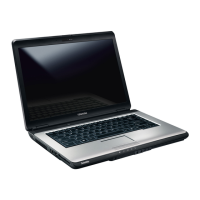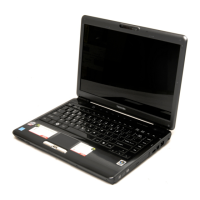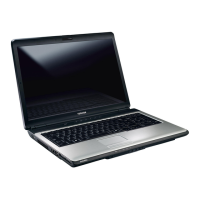
Do you have a question about the Toshiba Satellite L300 Series and is the answer not in the manual?
| Optical Drive | DVD SuperMulti Drive |
|---|---|
| Battery | 6-cell Lithium-ion |
| Processor | Intel Core 2 Duo |
| RAM | Up to 4GB DDR2 |
| Storage | 250GB HDD |
| Display | 15.4-inch, 1280x800 resolution |
| Graphics | Intel GMA |
| Operating System | Windows Vista |
| Wireless | Wi-Fi 802.11b/g |
| LAN | 10/100 Ethernet |
| Ports | 3 x USB 2.0, 1 x VGA, 1 x Headphone, 1 x Microphone |
Legal notice regarding reproduction and use of the manual's content.
Statement about the manual's accuracy and liability.
List of registered trademarks mentioned in the manual.
Guidelines for safe operation and handling of the computer.
FCC notice regarding compliance and interference.
Statement of compliance with European directives.
Information on Canadian radio noise emissions regulations.
Warning related to modem usage.
Information on network compatibility and requirements.
Selecting the correct region for modem operation in Japan.
Steps to take if telephone equipment malfunctions.
Explanation of Industry Canada certification and installation.
Warning and configuration for Australian modem compliance.
Notes on modem operation and compatibility in New Zealand.
Safety precautions for using laser systems in disc drives.
General safety precautions for using the computer.
List of items included with the computer.
Details on the physical components included with the computer.
List of preinstalled software for the computer.
Overview of the computer's features and benefits.
Information about the computer's built-in processor.
Details on memory types, slots, and specifications.
Information about hard disk drives and optical disc drives.
Description of the computer's built-in keyboard.
Details on the DVD Super Multi drive and supported formats.
Description of the computer's touchpad and control buttons.
Information on battery pack, RTC battery, and AC adaptor.
Details on available ports like headphone, microphone, USB, HDMI.
Information on PC Card, ExpressCard, and media card slots.
Details on web camera and sound system features.
Information on LAN, Wireless LAN, and modem capabilities.
Information on the security lock slot.
Details on operating system and TOSHIBA utilities.
Overview of unique or advanced computer features.
Description of preinstalled TOSHIBA component features.
Description of preinstalled utilities and how to start them.
Information on available optional devices to enhance the computer.
Identification of components on the computer's front with the display closed.
Switch to enable or disable wireless communication functions.
Slot for transferring data from various memory cards.
Identification of components on the computer's left side.
Identification of components on the computer's right side.
Identification of components on the computer's back side.
Identification of components on the computer's underside.
Identification of components on the computer's front with the display open.
LEDs indicating DC IN, power, battery, disk, media card status.
Description of the function buttons and their operations.
Indicators for CAPS LOCK and keypad overlay status.
Explanation of DVD region codes for compatibility.
Types of writable CD/DVD discs and usage.
Details on the AC adaptor's function and usage.
Steps to connect the AC adaptor for charging and power.
Instructions for opening the computer's display panel.
Steps for turning on the computer for the first time.
Methods for shutting down the computer (shut down, hibernate, sleep).
How to use hibernation mode to save power and data.
How to use sleep mode to save power.
Procedures for restarting the computer.
Information on system recovery partitions and menus.
Steps to create CD or DVD recovery discs.
Restoring software from the hidden recovery partition.
Restoring software from user-created recovery media.
How to use the touchpad for pointer control and selection.
How to use the computer's CD/DVD drives.
Step-by-step instructions for loading CDs/DVDs.
Step-by-step instructions for removing CDs/DVDs.
Description of the function buttons and their operations.
Instructions for writing data to CD-R/RW discs.
Instructions for writing data to DVD Super Multi drives.
Information about the TOSHIBA Disc Creator utility.
Steps to verify written or rewritten CD/DVD data.
Instructions for using Ulead DVD MovieFactory.
Simplified steps for creating a Labelflash DVD.
Steps for making a DVD-Video from captured video.
Tips for protecting data stored on CDs/DVDs.
Description of the bundled webcam utility.
How to use the built-in or external microphone.
How to use the face recognition login feature.
Steps to register facial data for login.
Procedure to delete facial recognition data.
Explains how to log in using face recognition.
Information about connecting and disconnecting the internal modem.
How to select the correct region for modem settings.
Modem Selection and Dialing Properties configuration.
Steps to connect and disconnect the internal modem cable.
Information on the computer's wireless communication support.
Details on Wireless LAN compatibility and features.
Recommendations for enabling encryption for Wireless LAN.
Steps to connect the computer to a LAN cable.
Precautions and methods for cleaning the computer.
Simple precautions for moving the computer safely.
How the computer manages heat and CPU temperature.
Description of the standard letter, number, and symbol keys.
Explanation of the 12 function keys at the top of the keyboard.
How to use the FN key with other keys for specific functions.
Simulating enhanced keyboard functions using FN key combinations.
Key combinations to enable/disable computer features.
How to make the FN key sticky for easier access to functions.
Special keys for activating Windows Start menu and mouse functions.
Description of the integrated numeric keypad overlay.
How to activate Arrow and Numeric modes for the keypad overlay.
Temporarily using normal keyboard functions with overlay active.
Temporarily using keypad overlay functions with normal keyboard.
Generating ASCII characters using keyboard overlay.
How power conditions affect computer operation and battery status.
Explanation of battery, DC IN, and power indicators.
How to interpret the battery indicator light.
Information on the types of batteries used in the computer.
Details on the removable lithium-ion battery pack.
Instructions for proper care and use of the battery pack.
Warnings and cautions regarding battery mishandling.
Critical warnings about battery disposal, disassembly, and short-circuiting.
Warnings about electrolyte fluid contact and battery inspection.
Cautions regarding impaired battery capacity and disposal.
Procedures for charging the computer's batteries.
Table showing approximate battery charging times.
Conditions that may affect battery charging.
Tips and settings to extend battery life.
Data retention times for different battery types when power is off.
Monthly procedure to fully discharge and recharge battery.
When and how to replace the battery pack.
Step-by-step guide to remove the battery pack.
Step-by-step guide to install a new battery pack.
How to start the computer using a registered password.
Overview of computer power-up modes (Boot, Hibernation, Sleep).
Setting power to turn off when display is closed.
System automatically shuts off if not used for a set duration.
Using TOSHIBA HW Setup to configure computer settings.
Steps to start the HW Setup utility.
Overview of HW Setup window tabs and buttons.
Setting or resetting the user password for power on.
Customizing display settings for internal LCD and external monitor.
Setting the display used when the computer boots.
Dynamic CPU Frequency Mode settings.
Setting the priority for booting the computer.
Settings for Wake-up on Keyboard feature.
Settings for Legacy USB Support.
Settings for Wake-up on LAN feature.
Enabling or disabling built-in LAN functions.
Optional devices for expanding computer capabilities.
Additional battery packs and AC adaptors.
Optional devices like USB FDD Kit, external monitor, HDMI.
Information on installing and using PC Cards and ExpressCards.
Steps to safely remove a PC Card or ExpressCard.
Slot for SD, SDHC, MS, MS Pro, MMC memory cards.
Step-by-step guide to install a RAM module.
Step-by-step guide to remove a RAM module.
Information on optional battery packs for increased portability.
Connecting an external analog monitor.
Connecting external display/audio devices via HDMI.
Setting audio devices for HDMI output or internal speakers.
Anchoring the computer with a security cable.
Guidelines for identifying and resolving computer problems.
Basic checks to perform before diagnosing problems.
Questions to ask when identifying a malfunctioning system.
Troubleshooting problems related to software or diskettes.
Troubleshooting hardware issues after checking preliminary items.
Checklist of computer hardware and peripherals for problem diagnosis.
Checks for problems when the computer fails to start.
Troubleshooting AC power connection issues.
Troubleshooting common battery-related problems.
Troubleshooting keyboard problems and configuration.
Troubleshooting display issues and screen markings.
Troubleshooting issues with the computer's hard disk drive.
Troubleshooting optical disc drive access and writing problems.
Troubleshooting touchpad and mouse issues.
Specific troubleshooting for touchpad responsiveness and tapping.
Troubleshooting issues with USB devices not working.
Troubleshooting modem initialization and connection problems.
Troubleshooting issues with entering sleep or hibernation modes.
Troubleshooting LAN access and Wake-up on LAN issues.
Troubleshooting Wireless LAN access problems.
Troubleshooting issues with Recovery Disc Creator.
Information on how to contact TOSHIBA for support.
Disclaimer regarding CPU performance variations.
Explanation of automatic shutdown as a protective feature.
Requirements for 64-bit computing hardware and software.
Disclaimer on how main memory is used for graphics.
Disclaimer on battery life variations and replacement.
Explanation of HDD capacity reporting and variations.
Disclaimer on LCD brightness deterioration over time.
Disclaimer on GPU performance variations.
Factors affecting wireless LAN transmission speed and range.
Recommendations for adjusting LCD brightness to prevent eye strain.
Operating and non-operating environmental conditions.
Specifications for the AC adaptor and computer power.
Technical specifications of the computer's built-in modem.
How the display controller interprets software commands into hardware.
Details on the modem's transmission speeds in V.90/V.92 mode.
Codes indicating connection status and speed for V.90.
Explanation of AT commands for modem control.
Form factor, compatibility, and OS for wireless LAN cards.
Factors affecting wireless LAN card performance.
Supported radio frequency bands for wireless LAN.
Information on wireless LAN channels and regulations.
Specifications for AC power cords and connectors.
List of certification agencies for power cords in Europe and globally.
List of abbreviations used in the manual.
Alphabetical listing and definitions of glossary terms.
Index entries for terms starting with 'A' through 'D'.
Index entries for terms starting with 'E' and 'F'.
Index entries for terms starting with 'G' and 'H'.
Index entries for terms starting with 'I' through 'L'.
Index entries for terms starting with 'M' through 'O'.
Index entries for terms starting with 'P' through 'T'.
Index entries for terms starting with 'U' through 'W'.










